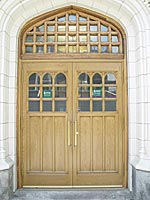The Pros and Cons of Restoring and Replacing Wood Windows
The Pros of Replication
Whatever the history of a building, whether it is significant in its own right, on the National Register of Historic Places, on a state or city's landmark list, or in an historic district-New York City has 55 landmark districts-each building is its own special case regarding window replacement versus window restoration decisions. Following is a compilation of the pros and cons.
|
||||
Replicated windows duplicate the design intention of the original building. Specifications can run the gamut from construction drawings showing elevations and plans of new and existing windows, to a note on the drawing of a facade stating "New wood European casement windows to match original building windows-type A." Experienced wood window replacement fabricators provide detailed shop drawings and are familiar with landmark and government standards.
The major benefit of replacement windows is that they are new, enhance thermal efficiency, and offer all the benefits of new design and the latest fabrication technology, including:
- Weather-stripping. Older windows have either minimal or no weather-stripping.
- Insulated glass enhances energy conservation. A single pane of glass has a U-value of 1.0. An insulated pane of the same size with a one quarter-inch air space has a U value of 0.5 that reduces heat loss by one half. Insulated glass also reduces noise transmission.
- Glazing options. Tinting can subtly affect the color of glass. Replication of the waviness and miniature bubbles of old glass is possible but expensive
- Open sash with minimal effort unlike old ones, which may be painted shut or difficult to open.
- Life cycle sustainability. High quality new windows are rated for 60-plus years.
- Lead paint removed along with the old windows.
- Ability to alter details to meet any client and architect requested design changes, provided the building is not required to conform to landmark standards.
- Replacement is usually less expensive than repair, unless the existing units are in very poor condition.
- Sash only may be replaced. As long as frames are in good condition and require little to no repairs, sash, weather-stripping, weights and chains, pulleys and stops can be specified. This will keep both the interior casing-wallboard and plaster-and the exterior casing-brick, mortar, and stucco-in check.
- Relatively easy to have a manufacturer replicate just one unit if that is what the project requires.
- Many soft and hardwood species are available so that replicated windows may be manufactured from the same wood species as the originals.
- Old windows can be removed and new replacements installed relatively quickly. This translates into less disruption for the occupants.
The Cons of Replication
Replicating existing windows may not always be the best solution for a project. The disadvantages are:
- Removal of existing windows can damage surrounding components, such as casing, wallboards, stucco, and plaster.
- Opening up a wall can sometimes lead to unknown issues. Cost can be prohibitive if the landmark body or historic commission imposes rigorous requirements as to the look, type, and action of replacement products.
- Cost can also be higher than restoration, depending upon the condition of the existing windows.
- Reviews of proposed replacement details by landmark and historic commission bodies can impact the project schedule. Typically, up to three months must be set aside for a review process.
The Pros of Restoration
- Original materials are preserved, as is the original design intent.
- Old growth wood from which old windows are made is very durable because it came from larger trees and has a tighter grain.
- Original glass can be retained which, if it is hand-blown or float glass, may be an important element in providing a period look worth keeping.
- Glazing options. A significant feature of the restored sashes from the Virginia Capitol Building restoration was the choice of low-iron glass, which avoided the greenish tint of ordinary glass.
- Less damage to the materials surrounding the wall cavity than if the existing window is removed.
- Can be just a minimal expense if the conditions of windows are not too deteriorated.
- A fresh coat of paint goes a long way to making old windows look good again.
- Many new products are available to restoration companies to aid in proper restorative techniques.
The Cons of Restoration
- Original windows usually contain layers of lead paint, which require specialized removal. Lead paint removal is very costly.
- Existing windows usually have single pane glass, which, if retained, offers occupants and owners no enhanced thermal benefits.
- Generally difficult to get a restoration contractor if the restoration project is a small one.
- Can be very expensive, depending on the condition of windows. Many wood components may need replacing and the sash rebuilding. This is usually done in a shop that means the window openings may be boarded up for quite some time.
- The time required to restore a window in place can be lengthy, which translates into more disruption to the occupants.
- Depending upon the extent of restoration, items such as weather-stripping, glazing putty, and hardware may be neglected and not replaced. This results in less thermal efficiency and more frequent repairs.











